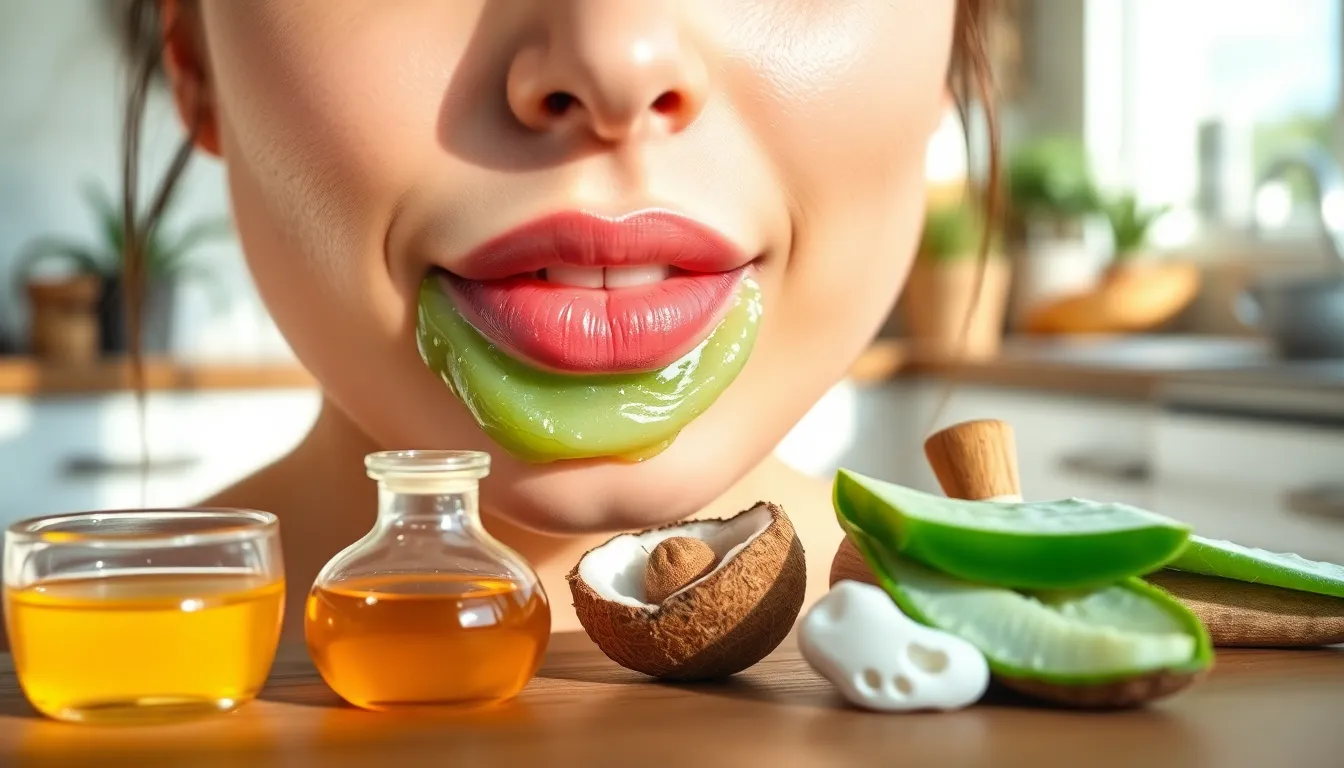Table of Contents
ToggleRedness around the lips can feel like a rogue tomato decided to take up residence on your face. It’s annoying and can steal the spotlight from your dazzling smile. But fear not! With a few simple home remedies, you can bid adieu to that unwelcome flush and reclaim your confidence.
Understanding Redness Around Lips
Redness around the lips often signals underlying issues. Identifying its causes and recognizing accompanying symptoms can help determine the best home remedies.
Common Causes
Several factors contribute to redness around the lips. Allergic reactions to lip products or food items frequently trigger inflammation. Irritation from harsh weather conditions, such as wind or sun exposure, can also exacerbate the issue. Skin conditions like eczema or psoriasis may lead to noticeable redness as well. Additionally, certain medical conditions, including herpes simplex, could provoke irritation. Hormonal changes during menstrual cycles can result in temporary redness, making awareness of individual sensitivities essential.
Symptoms to Look Out For
Symptoms associated with redness around the lips vary among individuals. Swelling often accompanies redness, indicating potential irritation. Itching or a burning sensation might also occur, suggesting sensitivity. Peeling or flaking skin signifies dehydration, further complicating the issue. Observing these symptoms can help in seeking appropriate remedies. If redness persists or worsens, consulting a healthcare professional should become a priority to rule out serious conditions.
Effective Home Remedies

Several effective home remedies can help alleviate redness around the lips. Utilizing natural ingredients and proper application techniques makes a significant difference in soothing irritated skin.
Natural Ingredients to Use
Aloe vera gel provides soothing properties that can calm inflammation. Coconut oil acts as a moisturizer, helping to hydrate and repair the skin barrier. Honey, known for its antibacterial properties, can aid in minimizing infection risk while promoting healing. Green tea contains antioxidants that support skin health and reduce redness. Calendula cream offers anti-inflammatory benefits, improving overall skin condition and reducing irritation, too. Oatmeal, when made into a paste, can soothe itchy skin and alleviate discomfort.
Application Techniques
Dabbing aloe vera gel gently around the lips promotes absorption without causing further irritation. Applying coconut oil in a thin layer helps seal in moisture throughout the day. Spreading honey onto the affected area provides a nourishing treatment that requires minimal effort and time. Using a cotton ball to apply green tea extracts ensures even coverage and enhances the calming effect. Massaging calendula cream into the skin supports circulation while allowing deeper penetration of beneficial ingredients. Creating an oatmeal paste involves mixing it with water until a smooth consistency develops, offering a soothing mask that reduces redness effectively.
Lifestyle Changes to Consider
Implementing lifestyle changes can significantly reduce redness around the lips. These adjustments encompass dietary modifications and enhancements to skincare routines.
Dietary Adjustments
Incorporating anti-inflammatory foods helps improve skin health. Leafy greens, fatty fish, and berries provide essential nutrients and antioxidants. Staying hydrated is crucial; drinking plenty of water supports overall skin hydration. Reducing processed foods may lessen the risk of allergic reactions. Avoiding common irritants, such as dairy and gluten, benefits some individuals who experience skin sensitivity. Maintaining a balanced diet ensures adequate vitamin intake, particularly vitamins A, C, and E, which promote skin repair and healing.
Skin Care Routine Improvements
Adjusting the skincare routine offers immediate relief from irritation. Choose gentle, fragrance-free products to minimize adverse reactions. Moisturizers containing ingredients like hyaluronic acid and glycerin boost hydration. Regular exfoliation aids in removing dead skin cells, but do it cautiously to avoid further irritation. Applying sunscreen specifically designed for the face protects sensitive skin from UV damage. Implementing a soothing product, such as aloe vera gel or calendula cream, after cleansing enhances skin comfort. Prioritizing a consistent routine fosters long-term skin health.
When to Seek Professional Help
Persistent redness around the lips requires attention from a healthcare professional. Individuals experiencing additional symptoms such as swelling, itching, or burning should consult a specialist. If redness doesn’t improve after home remedies or worsens, it’s important to seek medical advice.
Anyone with a history of skin conditions like eczema or psoriasis may benefit from an evaluation. Lip conditions related to herpes simplex also warrant examination by a professional. Hormonal changes sometimes contribute to redness, but significant changes should be addressed with a doctor.
Consultation becomes crucial for those with persistent swelling or painful cracks around the lips. Underlying allergies or sensitivities can lead to complications, highlighting the need for professional input. Lastly, if symptoms accompany fever, blisters, or significant discomfort, immediate medical attention is vital to rule out infections and other serious conditions.
Redness around the lips can be both uncomfortable and distracting. Thankfully there are effective home remedies that can help soothe and heal the skin. By utilizing natural ingredients like aloe vera, coconut oil, and honey, individuals can find relief and restore their confidence.
Incorporating lifestyle changes such as a balanced diet and a gentle skincare routine can further enhance results. It’s essential to pay attention to any persistent symptoms and seek professional advice when necessary. Taking proactive steps can lead to healthier skin and a brighter smile.





